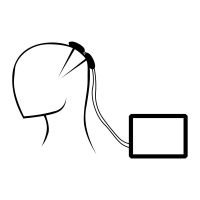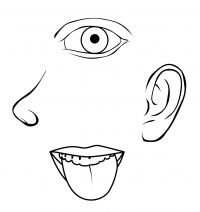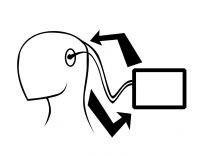If you're interested in becoming a contributor or requesting changes then click here to join the discord
Difference between revisions of "Brain Computer Interface Classification"
Jump to navigation
Jump to search
Landonodnal (talk | contribs) |
Landonodnal (talk | contribs) |
||
| (26 intermediate revisions by the same user not shown) | |||
| Line 1: | Line 1: | ||
| + | ==Invasiveness== | ||
| + | *Invasive | ||
| + | **Invasive BCIs are implanted inside the skull or brain. | ||
| + | [[File:invasive.jpg|none|200px|Invasive BCI]] | ||
| + | *Non-Invasive | ||
| + | **Non-invasive BCIs are placed outside of the skull. | ||
| + | [[File:Noninvasive.jpg|none|200px|Non-Invasive BCI]] | ||
| + | |||
| + | ==Activity== | ||
*Active BCI: | *Active BCI: | ||
**“An active BCI is a BCI which derives its outputs from brain activity which is directly consciously controlled by the user, independently from external events, for controlling an application.” | **“An active BCI is a BCI which derives its outputs from brain activity which is directly consciously controlled by the user, independently from external events, for controlling an application.” | ||
**Measures Phasic states (switching attention, type of imagined movement, ...) | **Measures Phasic states (switching attention, type of imagined movement, ...) | ||
| + | [[File:Active.jpg|none|200px|Active BCI]] | ||
*Reactive BCI: | *Reactive BCI: | ||
**“A reactive BCI is a BCI which derives its outputs from brain activity arising in reaction to external stimulation, which is indirectly modulated by the user for controlling an application.” | **“A reactive BCI is a BCI which derives its outputs from brain activity arising in reaction to external stimulation, which is indirectly modulated by the user for controlling an application.” | ||
**Measures Event-related states (surprised/not surprised, committed error, event noticed/not noticed, ...) | **Measures Event-related states (surprised/not surprised, committed error, event noticed/not noticed, ...) | ||
| + | [[File:Reactive.jpg|none|200px|Reactive BCI]] | ||
*Passive BCI: | *Passive BCI: | ||
**“A passive BCI is a BCI which derives its outputs from arbitrary brain activity without the purpose of voluntary control, for enriching a human-computer interaction with implicit information.” | **“A passive BCI is a BCI which derives its outputs from arbitrary brain activity without the purpose of voluntary control, for enriching a human-computer interaction with implicit information.” | ||
**Measures Tonic states (degree of “relaxation”, cognitive load, ...) | **Measures Tonic states (degree of “relaxation”, cognitive load, ...) | ||
| + | [[File:Passive.jpg|none|200px|Passive BCI]] | ||
| + | [https://www.pantechsolutions.net/blog/brain-computer-interface/ Source] | ||
| + | ==Input and Output== | ||
These are the 5 types of BCI systems based on the possible combinations of input and output sources for the brain (neuroimaging / neurostimulation) and body (peripheral inputs and outputs such as keyboards and screens). | These are the 5 types of BCI systems based on the possible combinations of input and output sources for the brain (neuroimaging / neurostimulation) and body (peripheral inputs and outputs such as keyboards and screens). | ||
*[A] Open-Loop Efferent BCI | *[A] Open-Loop Efferent BCI | ||
**Brain signals control an external device. | **Brain signals control an external device. | ||
***An example is the original BrainGate BCI where an implantable array let a patient control a computer cursor. | ***An example is the original BrainGate BCI where an implantable array let a patient control a computer cursor. | ||
| + | [[File:A.jpg|none|200px|Open-Loop Efferent]] | ||
*[B] Open-Loop Afferent BCI | *[B] Open-Loop Afferent BCI | ||
**Electrical stimulation to the brain by a device. | **Electrical stimulation to the brain by a device. | ||
***An example is the original deep brain stimulation (DBS) used for Parkinson's treatment in which a neural implant gives off stimulation to the brain. | ***An example is the original deep brain stimulation (DBS) used for Parkinson's treatment in which a neural implant gives off stimulation to the brain. | ||
| + | [[File:B.jpg|none|200px|Open-Loop Afferent]] | ||
* [C] Closed-Loop Efferent BCI | * [C] Closed-Loop Efferent BCI | ||
**Brain signals control an external device and then feedback is given to the user that enables them to change brain signals. | **Brain signals control an external device and then feedback is given to the user that enables them to change brain signals. | ||
| − | **An example would be the BrainGate BCI, in which the computer with the cursor also gave off instructions due to the signals it was picking up that then are relayed back to the patient to change the brain signals and thereby affect cursor control. | + | ***An example would be the BrainGate BCI, in which the computer with the cursor also gave off instructions due to the signals it was picking up that then are relayed back to the patient to change the brain signals and thereby affect cursor control. |
| − | * [D] Closed-Loop Afferent BCI | + | [[File:C.jpg|none|200px|Closed-Loop Efferent]] |
| − | + | *[D] Closed-Loop Afferent BCI | |
| − | **Electrical stimulation to the brain by a device and moderated by movement monitoring | + | **Electrical stimulation to the brain by a device and moderated by movement monitoring |
***An example is a Parkinson's DBS-BCI in which a tremor of the wrist causes the electrical stimulation to change. | ***An example is a Parkinson's DBS-BCI in which a tremor of the wrist causes the electrical stimulation to change. | ||
| + | [[File:D.jpg|none|200px|Closed-Loop Afferent]] | ||
*[E] Bidirectional Afferent Closed-Loop BCI | *[E] Bidirectional Afferent Closed-Loop BCI | ||
**Electrical stimulation to the brain is modulated depending on the recordings. | **Electrical stimulation to the brain is modulated depending on the recordings. | ||
*** An example is Neuropace's BCI in treating epilepsy in which recordings of brain signals are used to modulate the electrical stimulation output. | *** An example is Neuropace's BCI in treating epilepsy in which recordings of brain signals are used to modulate the electrical stimulation output. | ||
| − | + | [[File:E.jpg|none|200px|Bidirectional Afferent Closed-Loop ]] | |
| − | + | [https://jsf.co/wp-content/uploads/2020/08/JSF_Brain_Computer_Interfaces.pdf Source] | |
Latest revision as of 23:20, 20 October 2021
Invasiveness
- Invasive
- Invasive BCIs are implanted inside the skull or brain.
- Non-Invasive
- Non-invasive BCIs are placed outside of the skull.
Activity
- Active BCI:
- “An active BCI is a BCI which derives its outputs from brain activity which is directly consciously controlled by the user, independently from external events, for controlling an application.”
- Measures Phasic states (switching attention, type of imagined movement, ...)
- Reactive BCI:
- “A reactive BCI is a BCI which derives its outputs from brain activity arising in reaction to external stimulation, which is indirectly modulated by the user for controlling an application.”
- Measures Event-related states (surprised/not surprised, committed error, event noticed/not noticed, ...)
- Passive BCI:
- “A passive BCI is a BCI which derives its outputs from arbitrary brain activity without the purpose of voluntary control, for enriching a human-computer interaction with implicit information.”
- Measures Tonic states (degree of “relaxation”, cognitive load, ...)
Input and Output
These are the 5 types of BCI systems based on the possible combinations of input and output sources for the brain (neuroimaging / neurostimulation) and body (peripheral inputs and outputs such as keyboards and screens).
- [A] Open-Loop Efferent BCI
- Brain signals control an external device.
- An example is the original BrainGate BCI where an implantable array let a patient control a computer cursor.
- Brain signals control an external device.
- [B] Open-Loop Afferent BCI
- Electrical stimulation to the brain by a device.
- An example is the original deep brain stimulation (DBS) used for Parkinson's treatment in which a neural implant gives off stimulation to the brain.
- Electrical stimulation to the brain by a device.
- [C] Closed-Loop Efferent BCI
- Brain signals control an external device and then feedback is given to the user that enables them to change brain signals.
- An example would be the BrainGate BCI, in which the computer with the cursor also gave off instructions due to the signals it was picking up that then are relayed back to the patient to change the brain signals and thereby affect cursor control.
- Brain signals control an external device and then feedback is given to the user that enables them to change brain signals.
- [D] Closed-Loop Afferent BCI
- Electrical stimulation to the brain by a device and moderated by movement monitoring
- An example is a Parkinson's DBS-BCI in which a tremor of the wrist causes the electrical stimulation to change.
- Electrical stimulation to the brain by a device and moderated by movement monitoring
- [E] Bidirectional Afferent Closed-Loop BCI
- Electrical stimulation to the brain is modulated depending on the recordings.
- An example is Neuropace's BCI in treating epilepsy in which recordings of brain signals are used to modulate the electrical stimulation output.
- Electrical stimulation to the brain is modulated depending on the recordings.









